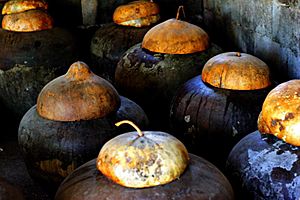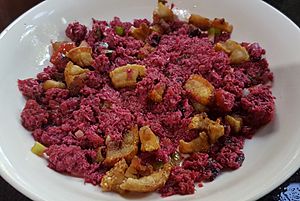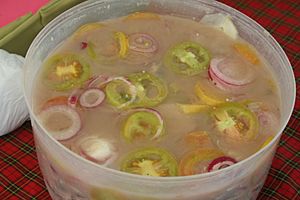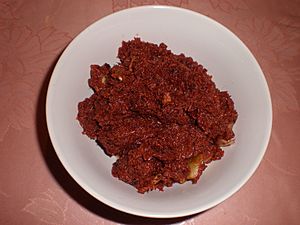Bagoong facts for kids

Traditional burnay jars containing fermenting bagoong in Ilocos Norte
|
|
| Type | Condiment |
|---|---|
| Region or state | Philippines |
| Associated national cuisine | Philippines |
| Main ingredients | Fish |
Bagoóng (pronounced buh-goo-ONG) is a popular condiment from the Philippines. It is made by mixing either fish or tiny shrimp (called krill) with salt and letting them ferment. This means they are left to change over time, which gives them a special flavor. During this process, another liquid called patís (fish sauce) is also made.
The way bagoong is prepared can be a little different depending on where you are in the Philippines.
Contents
Types of Bagoong
Bagoong can be made from many different kinds of fish. Here are some common ones:

- Anchovies (called dilis or monamon)
- Round scads (called galunggóng)
- Bonnetmouths (called terong)
- Ponyfish (called sapsáp)
- Rabbitfish (called padas)
- Herrings
- Silver perch (called ayungin)
When bagoong is made from fish, it's often called bagoóng isdâ, which means "fish bagoong." For example, bagoong made from anchovies is known as bagoong monamon or bagoong dilis.
In the southern parts of the Philippines, fish bagoong made from anchovies is also called guinamos. If larger fish are fermented, they are known as tinabal.
Bagoong can also be made from krill, which are very small shrimp-like creatures. This type is called bagoong alamang. It has different names in various regions, like uyap or alamang in the south, and aramang in Ilocos.
Sometimes, though less often, bagoong can even be made from oysters, clams, or fish and shrimp eggs.
How Bagoong is Made

Making Fish and Shrimp Paste
To make bagoong isda, fish and salt are mixed together. The exact amounts can vary for different makers. The mixture is usually stirred by hand until the fish and salt are well combined. Then, it's put into large clay jars, called tapayan or burnay. These jars are covered to keep flies away. The mixture is left to ferment for about 30 to 90 days. It's stirred sometimes to make sure the salt spreads evenly. The mixture can grow quite a bit during this time.
Making bagoong alamang (shrimp or krill paste) is similar. The krill are cleaned and washed in a light salt water solution. Then, they are mixed with salt. Usually, it's about 25% salt to 75% krill by weight.
After fermentation, the bagoong is usually light gray or white. To get the reddish or pink color you sometimes see, a natural food coloring called angkak is added. Angkak comes from rice that has been mixed with a special red mold. Using good quality salt is important because too much metal in the salt can make the bagoong darker and taste less good. Also, using too much or too little salt can affect how well the fermentation works. Some makers grind the finished bagoong into a smooth paste.
Making Patís (Fish Sauce)
Patís, or fish sauce, is a clear, yellowish liquid that forms on top of the fermenting bagoong mixture. It has a strong, salty, or cheese-like flavor. Many countries in Asia have similar fish sauces, like nước mắm in Vietnam or nam pla in Thailand. Even ancient Greeks and Romans had a similar sauce called garum.
To get patís, the fermentation process is much longer, usually from six months to a year. During this longer time, the fish or shrimp break down even more. This creates the clear, yellowish liquid on top. Once the patís has its special smell, it can be collected. It is then drained, heated to make it safe (pasteurized), and bottled. The solid parts left behind are then used to make bagoong. Sometimes, more salt water is added to the solids if they are too dry. The speed of fermentation can change depending on how warm it is and how acidic the mixture is. Being exposed to sunlight can also make the process faster, sometimes as quick as two months.
Bagoong's Place in History
For a long time, people from Western countries were not familiar with bagoong. This sometimes made it seem like an "exotic" or unusual food. Early descriptions of bagoong were sometimes negative. For example, a Spanish official named Antonio de Morga wrote in his book that bagoong was "fish which... has started to rot and stink."
However, a famous Filipino hero, Jose Rizal, strongly disagreed with this description in 1890. He wrote that this was just because the Spanish were not used to the food. He said that bagoong is not rotten and is very good to eat. This shows how important bagoong is to Filipino culture and identity.


